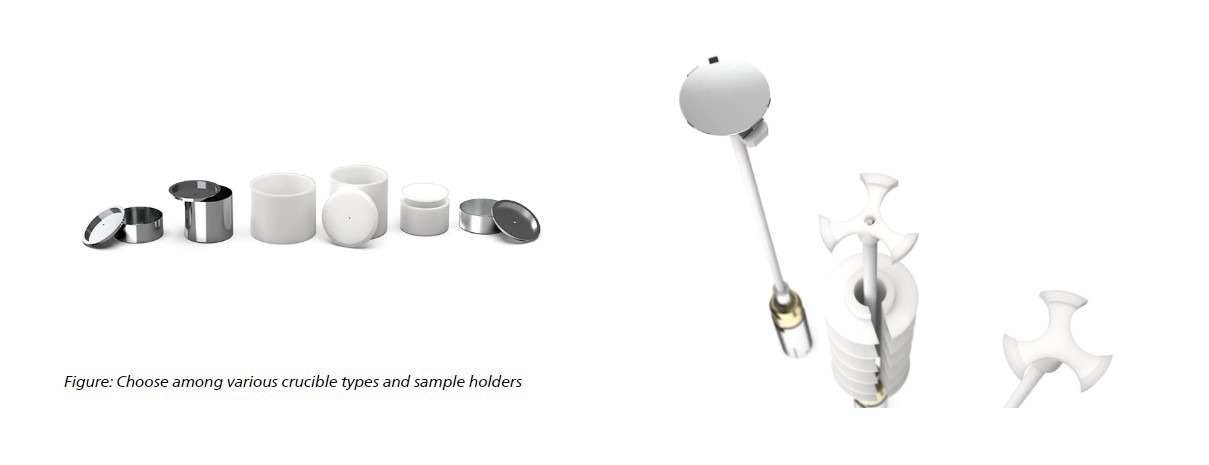Thermogravimetric analysis (TGA) is a method of thermal analysis employed for measuring mass changes as a function of temperature or time. This provides information on, for example, absorption, desorption, thermal stability, corrosion resistance, plasticizer/carbon black/ash content, additives and solvent residues.
Along with high-temperature applications, such as ceramics, glass, and metals, thermogravimetric analysis is also of great benefit in other industries, including organic chemistry, pharmacy, medical technology, biotechnology, the food industry and, last but not least, the all-important plastics industry.
Following our NETZSCH TG Iris, Tarsus®and Nevio models, it was above all the NETZSCH TG 209 F1 Libra® with its fast ceramic furnace to 1100°C that enjoyed lasting popularity within the last years. Today, we will introduce the next generation of the NETZSCH thermobalance!

Figure: From the very first thermobalance by NETZSCH in 1959 to the latest innovation: the TG 309 Libra®. Image Credit: Netzsch
Ensure Product Quality and Safety with the New TG 309 Libra®
Today, we are proud to introduce our latest innovation- the new thermobalance TG 309Libra®,distinguished with our new award-winning design. By combining state-of-the-art technology with proven reliability and precision, our product helps you gain a better understanding of your materials than ever before.
The NETZSCH TG 309 Libra® introduces new technical specifications for improved testing performance by remaining the typical robustness and ease-of-use of our top-loading NETZSCH TGAs.
One TGA Series, Three Instruments - A Solution for Every Need
As introduced for our new DSC 300 Caliris® series, also the TG Libra® 309 comes in three models, tailored to cover a wide range of applications:
The TG 309 Libra®Supreme can also be coupled to the QMS 403 D Aëolos® Quadrupole Mass Spectrometer and/or to an FT-IR Spectrometer or to a GC-MS to investigate the gases released.

Figure: The new NETZSCH TG 309 Libra®Supreme. Image Credit: Netzsch
Check out What´s New!
- Top-loading ultra-sensitive weighing system: Outstanding balance resolution of up to 10 ng
- Eco Mode feature to shut off thermostat when not in use: Improves efficiency, reduces environmental impact and saves costs
- Four mass flow controllers to streamline gas switching and mixing: No need to change and clean gas connections, saving the user valuable time and minimizing clogging risks
- Unique magnetic dampers eliminate environmental effects: Magnetic levitation separates the instrument from the surface on which the thermobalance stands. In this way, measurement effects are not superimposed by external influences.
- Various user-exchangeable sample carriers, including corrosion-resistant and high sensitivity, sensors, for specific applications and reduced maintenance costs
- Vacuum-tight design for tests under reduce pressure or under precise controlled inert atmosphere,
- Integrated LED status bar and display: Real-time measurement visualization and analysis status check, ensuring user-friendly experience
- Award-winning product design: German Design Award winner for enhanced aesthetics and usability
TG 309 Libra Series
Various Accessories Available!
The new TGA instrument series introduces a broad selection of crucible types of different materials, offered in various volumes, tailored to accommodate your individual research demands. It also provides a choice among multiple sample carriers, featuring corrosion-resistant sensors, high-precision c-DTA®® sensors for advanced observation of thermal phenomena, and sensors designed for extensive sample volumes. These carriers can be easily replaced in less than 60 seconds and are automatically recognized by the device.
Image Credit: Netzsch
An Automatic Sample Changer (ASC) can be easily programmed by means of the Proteus®SmartMode software function. The Automatic Sample Changer of the TG 309 Libra®Select and Supreme is designed to hold two interchangeable sample trays, each holding 96 samples.
Take a look into our Accessories Catalogue to find out more!
Get your Measurement Results Even Faster with the Proteus® 9 Software
The new TGA 309 series comes with the latest Proteus® 9 version. The Proteus® software offers many new features, such as “Customized Menu” and “Workspaces”: The operator can individually configure the working environment in the analysis from the entire pool of functionalities. By means of the Proteus® Search Engine, users can search for measurement and analysis files, filter or sort them – ideal for fast quality control!
But, that is not all! Get to know the software features at a glance:
- BeFlat®: In typical measurements, in order to ensure correct mass change values, a baseline run is carried out under identical test conditions for variables such as heating rate, gas type, gas flow rate, crucible type and geometry, etc., and subtracted from the sample measurement. In contrast, the TG 309 Libra® generally no longer requires a separate baseline correction when using the integrated BeFlat® baseline run for typical temperature profiles.
- AutoCalibration: This function offers automatic routines to generate calibration curves and allows you to fully concentrate on your measurement tasks
- Use SmartMode as an intuitive interface for fast measurement setup! It allows you to quickly and easily prepare and start measurements for tasks using clearly defined measurement procedures.
- ExpertMode: You want to dive deeper into the software for advanced option setting or method definition? Just switch from SmartMode to ExpertMode. ;-)
Speed Up your Results!
Of course, TGA 309 Libra® users benefit from our state-of-the-art Proteus® functions AutoEvaluation and Identify: The DSC polymer AutoEvaluation function is a self-acting operator-independent evaluation routine. For thermogravimetry measurements, it autonomously and instantly evaluates all significant mass changes. It also generates the derivative curve, DTG, and automatically evaluates the corresponding peak temperatures.
Use the Identify feature as a unique tool for automatic curve recognition and identification to classify your material. Besides 1:1 comparisons with individual database measurements or literature data, it is also possible to compare a measurement with material classes.
Eager to know more features and learn, how they can make your work easier?
Visit our NETZSCH Thermobalance website or download our latest NETZSCH TGA brochure.